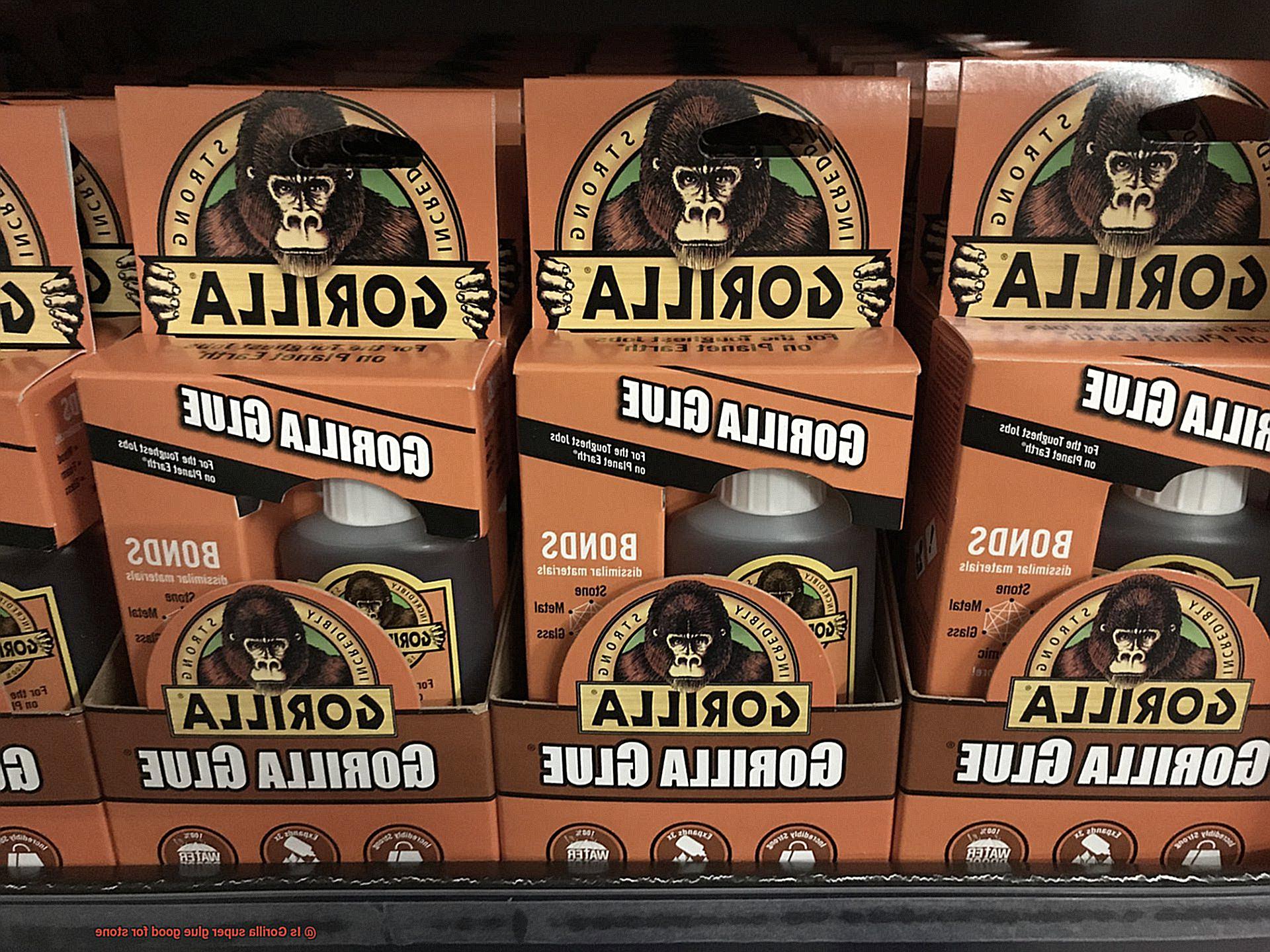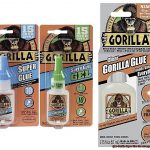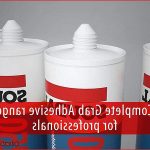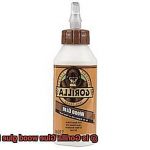Curious if Gorilla Super Glue can handle the rock-solid challenge of bonding stone?
Look no further, my friend. In this blog post, we’re diving deep into the sticky world of stone adhesion.
Brace yourself for a rollercoaster ride of effectiveness, versatility, and potential pitfalls. But fear not, because we’ve got your back with some nifty tips and tricks to ensure your stone-bonding endeavors are a smashing success.
Trust me, you won’t want to miss this.
What is Gorilla Super Glue?
Contents
- 1 What is Gorilla Super Glue?
- 2 Stone Surfaces and Porosity
- 3 Types of Stone Suitable for Gorilla Super Glue
- 4 Cleaning and Preparing the Stone Surface
- 5 Applying Gorilla Super Glue on Stone
- 6 Benefits of Using Gorilla Super Glue on Stone
- 7 Limitations of Using Gorilla Super Glue on Stone
- 8 Tips for Getting the Best Results When Using Gorilla Super Glue on Stone
- 9 Conclusion
When it comes to bonding stone surfaces, finding an adhesive that delivers strength, durability, and versatility is paramount. Enter Gorilla Super Glue. In this article, we will delve into the remarkable features and benefits of Gorilla Super Glue, explore its compatibility with different types of stone, and share valuable tips for achieving optimal results.
What is Gorilla Super Glue?
Gorilla Super Glue is a renowned cyanoacrylate adhesive celebrated for its formidable and enduring bond. This specially formulated glue is designed to work effectively on various materials, including stone, making it an exceptional choice for stone-related projects.
Features and Benefits:
- Rapid-Drying Formula: With Gorilla Super Glue, you can say goodbye to waiting around. It sets within seconds, eliminating the need for clamping or holding pieces together for extended periods.
- Unrivaled Strength and Durability: This glue forms a powerful bond that can withstand the rigors of everyday life, from impacts to moisture and even temperature changes.
- Remarkable Versatility: Gorilla Super Glue thrives on both porous and non-porous stone surfaces, making it suitable for an extensive range of stones such as granite, marble, slate, and more.
- Tailored Variants for Specific Needs: Gorilla offers gel formulas for enhanced control during application and impact-tough formulas reinforced with rubber particles that offer superior resistance to impacts and vibrations.
Suitability for Different Types of Stone:
While Gorilla Super Glue excels on stone surfaces like granite, marble, and slate, its effectiveness may vary on more porous stones such as sandstone or limestone. Therefore, it is prudent to test the glue on a small area before embarking on larger applications.
Tips for Optimal Results:
- Surface Preparation Prowess: Thoroughly cleanse the stone surface with a mild detergent and water to eliminate any dirt or dust that could compromise the bond.
- Embrace Texture: Gently roughen the surface with sandpaper to enhance the adhesive’s grip on the stone, ensuring an unyielding connection.
- Less is More: Apply Gorilla Super Glue sparingly and evenly to both surfaces being bonded to avoid any excess glue oozing out.
- The Power of Pressure: Apply sustained pressure to the bonded surfaces for a few minutes, using clamps or heavy objects, to guarantee an unbreakable bond.
Stone Surfaces and Porosity
When it comes to bonding stone surfaces, understanding the porosity of the material is crucial. In this article, we will explore the fascinating world of stone porosity and its impact on Gorilla super glue’s performance.
By delving into the different types of stone and their porosity levels, testing methods, the influence of surface finish and sealants, and emphasizing proper surface preparation, we will uncover the secrets to achieving unbreakable bonds.
Understanding Porosity:
Porosity refers to a material’s ability to absorb liquids or gases. In the context of stone surfaces, it determines how well an adhesive can penetrate and bond with the material. Each type of stone possesses varying levels of porosity. For instance, marble and limestone exhibit higher porosity compared to granite or slate.
Testing Porosity:
To determine the porosity of a stone surface, a simple test can be performed. Place a few drops of water on the surface and observe how quickly it is absorbed. Rapid absorption indicates higher porosity, while water that remains on the surface or forms droplets suggests lower porosity.
Impact on Bonding:
The porosity of a stone surface directly influences Gorilla super glue’s adhesive properties. Highly porous stones like marble and limestone tend to absorb liquid materials, including glue. As a result, weak adhesion or bond failure may occur. Conversely, less porous stones like granite or slate provide more suitable surfaces for bonding with Gorilla super glue.
Surface Finish and Sealants:
In addition to natural porosity, surface finish and sealants significantly affect stone porosity. Polished surfaces generally have lower porosity compared to rough or honed surfaces. Moreover, applying sealants can reduce stone porosity and enhance compatibility with Gorilla super glue.
Proper Preparation is Key:
While porosity is a crucial factor, it is essential to note that proper surface preparation is equally important for achieving strong and durable bonds. Before applying Gorilla super glue, ensure the stone surface is clean and free from dirt, dust, or residue that may hinder adhesion.
Types of Stone Suitable for Gorilla Super Glue
When it comes to bonding stone surfaces, Gorilla Super Glue can be a reliable choice. However, not all types of stone are suitable for this adhesive. It is important to understand which stones can effectively bond with Gorilla Super Glue. Let’s explore the different types of stone that can be securely bonded with this powerful adhesive.
Granite is a popular option for countertops and flooring due to its strength and durability. Luckily, Gorilla Super Glue is an excellent adhesive for granite surfaces. It forms a robust bond that can withstand heavy use and weight. Whether you’re bonding granite countertops or flooring, Gorilla Super Glue will provide a reliable and long-lasting bond.
Marble, on the other hand, requires a more delicate touch. While it is softer than granite, Gorilla Super Glue can still be used to bond marble surfaces effectively. However, caution must be exercised as marble can be easily scratched or damaged. Apply the glue with care, ensuring that excessive pressure is not applied to avoid any cracks or breakage.
Limestone is a versatile sedimentary rock commonly used in construction and landscaping projects. Gorilla Super Glue can be used on limestone surfaces, but it is crucial to keep it away from water or moisture. Exposure to moisture may weaken the bond, so it’s best to use this adhesive in dry environments.
Sandstone is another widely used stone for indoor and outdoor applications. However, its porous nature requires special attention when selecting an adhesive. Gorilla Super Glue can be used on dry sandstone surfaces, but it should not be employed in areas exposed to moisture or high humidity. Proper surface preparation and avoiding contact with water are key to a successful bond.
Slate, a fine-grained metamorphic rock, is commonly used for roofing, flooring, and wall cladding. Gorilla Super Glue is highly effective on slate surfaces, providing a strong bond that can withstand various weather conditions. Whether you’re working on roofing projects or interior applications, this adhesive will deliver reliable results.
Cleaning and Preparing the Stone Surface
When it comes to tackling a DIY stone project, whether it’s repairing a cracked countertop or creating a stunning mosaic, cleaning and preparing the stone surface is a crucial step in achieving a strong and long-lasting bond with any adhesive, including Gorilla super glue. So, let’s dive into the nitty-gritty of this process and get those stones ready for your DIY dreams.
First things first, you’ll need to gather a mild detergent or soap, as well as some water. Mix them together and grab a soft brush or sponge. Gently scrub the stone surface to remove any dirt, dust, or grease that may be lingering around. Rinse the surface thoroughly with clean water to ensure there are no residues left behind. We want that stone squeaky clean.
Once the surface is clean, it’s time to dry it completely. Moisture can interfere with the bonding process, so grab a clean cloth or towel and remove any excess water. We don’t want any wet spots ruining our glue party.
Now, if your stone surface has been previously sealed or coated, you may need to remove those layers before applying the glue. Check with the manufacturer’s instructions for suitable solvents or chemical strippers that can get the job done. And don’t forget to protect your hands with gloves and your eyes with eyewear. Safety first.
Once the stone surface is clean and dry, let’s give it a little roughening up. Grab some fine-grit sandpaper or a wire brush and lightly sand the surface or create small scratches. We’re not looking for major alterations here, just a little grip enhancement. This roughened area will provide a better adhesion surface for the adhesive.
Before you bust out that Gorilla super glue (or any other adhesive), take a moment to read and follow the manufacturer’s instructions carefully. Different types of stone may require specific preparation techniques or primers, so it’s vital to understand their recommendations. This will ensure the best results for your project.
Applying Gorilla Super Glue on Stone
When it comes to bonding stone surfaces, Gorilla Super Glue is the superhero you need by your side. Whether you’re fixing a broken sculpture or creating a stunning stone masterpiece, this powerful adhesive is up to the task. But before you embark on your stone project, let’s dive into the step-by-step process of applying Gorilla Super Glue to ensure a bond that’s as strong as Hercules himself.
- Cleanliness is key: Before applying Gorilla Super Glue on stone, give your surfaces a thorough cleaning. Use a mild detergent and water to scrub away any dirt, dust, or debris that might hinder the bonding process. A clean surface equals a strong bond.
- Roughen it up: After your stone surface is squeaky clean and bone dry, grab some sandpaper and gently create a rough texture on the area where the glue will be applied. This step helps create a better bond between the glue and the stone, ensuring your project stands the test of time.
- Compatibility test: Don’t skip this crucial step. Apply a small amount of Gorilla Super Glue on an inconspicuous area of the stone to check for any discoloration or damage that may occur. Better safe than sorry.
- Less is more: Remember, a little goes a long way with Gorilla Super Glue. Apply only a small amount of glue onto one surface of the stone, avoiding the edges to prevent seepage during bonding. You don’t want glue oozing out like an overfilled sandwich.
- Press and hold: Once you’ve applied the glue, bring the stone surfaces together and press them firmly. Hold them in place for at least 30 seconds. Applying consistent pressure is essential for a strong bond. Consider using clamps or heavy objects for extra support with larger pieces.
- Patience is a virtue: Give the glue ample time to dry and cure completely before subjecting it to stress or pressure. Follow the instructions provided by Gorilla Super Glue for their recommended drying times. Rushing this step can lead to disappointing results and a weakened bond.
- Inspect and repeat: After the glue has dried, inspect your masterpiece carefully. If you spot any gaps or weak spots, don’t panic. Apply a little more Gorilla Super Glue and repeat the bonding process. We’re all about resilience and second chances here.
Remember, not all stones were created equal. Some delicate types, like marble or granite, may not play well with Gorilla Super Glue and could end up damaged or discolored. Always check the manufacturer’s instructions and test on a small, inconspicuous area before applying the glue on valuable or delicate stone surfaces.
In case of accidental spills or excess glue, clean it immediately with acetone or nail polish remover. Be cautious, as these solvents can also damage certain types of stone. Test in an inconspicuous area first and use sparingly.
Benefits of Using Gorilla Super Glue on Stone
When it comes to stone projects, finding the right adhesive can be a challenge. But fear not, because Gorilla Super Glue is here to save the day. This powerful adhesive offers a range of benefits that make it the perfect choice for bonding stone surfaces. From its Herculean bonding power and rapid cure time to its weatherproof resilience and versatile application, Gorilla Super Glue is the ultimate hero for your stone projects.
Herculean Bonding Power:
Gorilla Super Glue is specially formulated to create a strong and durable bond on various materials, including stone. Its innovative formula allows it to penetrate porous surfaces and adhere to uneven textures, making it ideal for bonding stones together. Say goodbye to weak bonds and hello to unbreakable connections that can withstand heavy loads and constant use.
Rapid Cure Time:
Time is of the essence when working with stone surfaces, as any movement or shifting can compromise the integrity of your project. Thankfully, Gorilla Super Glue dries quickly, allowing you to complete your project in a timely manner. No more waiting around for hours – this fast-setting adhesive ensures that your stone pieces stay securely in place.
Weatherproof Warrior:
Stone surfaces often face the wrath of Mother Nature, enduring exposure to water, heat, and cold. With Gorilla Super Glue, you can rest easy knowing that your bond will remain intact even in harsh outdoor conditions. Its exceptional resistance to water and extreme temperatures ensures that your stone project stands strong against the elements and passes the test of time.
Versatile Adhesive:
Whether you’re working with granite, marble, limestone, or other types of stone, Gorilla Super Glue has got you covered. This versatile adhesive can bond various types of stone together, making it suitable for a wide range of projects. From small DIY endeavors to larger construction undertakings, Gorilla Super Glue is up for the challenge, providing a reliable and efficient solution for all your stone bonding needs.
Easy Application:
Applying Gorilla Super Glue is a breeze, thanks to its convenient bottle and easy-to-use applicator. With precise and controlled application, you can ensure that the glue goes exactly where it’s needed, without any mess or waste. Say goodbye to sticky fingers and hello to hassle-free bonding that saves you time and effort.
Rock-Solid Durability:
Once Gorilla Super Glue has cured, it forms a permanent bond that can withstand the test of time. Your stone project will stay securely in place, even with regular use and exposure to external factors. Trust in the durability of Gorilla Super Glue for long-lasting results that maintain the integrity of your stone creations.
Limitations of Using Gorilla Super Glue on Stone
When it comes to bonding stone surfaces, Gorilla Super Glue may not always be the ideal choice. While this adhesive has its strengths, it also has certain limitations that need to be taken into consideration before using it on stone. In this article, we will explore the various limitations of using Gorilla Super Glue on stone surfaces.
Porosity Predicament:
Stone surfaces, such as marble, granite, or limestone, are known for their porosity. The microscopic holes present in these materials can make it challenging for Gorilla Super Glue to penetrate and form a strong bond. Without proper seepage into these tiny crevices and gaps, the bond may end up weaker than expected.
Rough and Tough:

Stone surfaces can be rough and uneven, which can pose a challenge for Gorilla Super Glue. This adhesive works best on smooth and flat surfaces that maximize contact, ensuring a solid bond. However, on rough or uneven stone surfaces, the glue may struggle to adhere correctly, leading to a weaker bond or even failure.
Weight Woes:
While Gorilla Super Glue is known for its strength and durability, it may not be suitable for heavy-duty applications on stone surfaces. Stone can be quite heavy on its own, and if the glue isn’t able to withstand the weight or pressure applied, it can result in a failed bond. It’s crucial to consider the weight-bearing capacity of the glue when working with stone.
Environmental Extremes:
Stone creations are often exposed to harsh environmental conditions. Extreme temperatures, high humidity levels, and exposure to water can weaken the bond created by Gorilla Super Glue over time. If your stone project will face these challenges, it’s important to choose an adhesive that can withstand such environmental factors.
Specialized Stone Solutions:
Gorilla Super Glue is a versatile adhesive, but it’s not specifically formulated for bonding stone surfaces. There are specialized adhesives available that are designed to tackle the unique characteristics of stone, offering better adhesion properties and a more suitable bonding solution. It may be worth exploring these alternatives for your stone projects.
Tips for Getting the Best Results When Using Gorilla Super Glue on Stone
Look no further than Gorilla Super Glue, a formidable adhesive known for its strength and durability. To ensure the best results, it’s important to follow some essential tips. In this article, we will delve into the step-by-step process of using Gorilla Super Glue on stone, unlocking the secrets to achieving flawless bonds.
Unleash the Power of Cleanliness:
Before applying Gorilla Super Glue to your stone surface, cleanliness is paramount. Imagine trying to create a seamless bond between two surfaces while dirt and debris lurk beneath. Use a mild detergent or stone cleaner to delicately scrub away any contaminants. Rinse thoroughly, allowing the surface to dry completely before proceeding.
Embrace the Roughness:
To take your bond to new heights, consider embracing a little roughness. Gently roughen the stone surface with sandpaper or a fine-grit abrasive pad. This creates small scratches and grooves, providing the perfect texture for the glue to grip onto. Take care not to exert excessive pressure that may harm the stone.
Less is More:
When it comes to using Gorilla Super Glue on stone, remember that less is more. Apply a small amount of glue evenly onto one surface, then join the two surfaces together firmly. Avoid giving in to the temptation of using excess glue, as it can lead to messy residue and compromise the integrity of your bond.
The Power of Pressure:
Harness the power of pressure during the bonding process by using clamps or weights. These trusty tools lend a helping hand, ensuring that your bond is strong and secure. Be mindful of not putting too much pressure that could potentially damage or crack the precious stone you’re working with.
Patience is a Virtue:
While Gorilla Super Glue sets quickly, patience is still a virtue. Allow sufficient drying time for the glue to work its magic. Consult the manufacturer’s instructions, as drying times can vary from a few minutes to an hour. Refrain from disturbing or moving the glued objects until the glue has fully dried and cured.
Shield from Moisture:
Gorilla Super Glue boasts water resistance, but don’t let that lull you into complacency. Prolonged exposure to moisture can weaken bonds over time. To safeguard against this, consider applying a waterproof sealant or coating over the glued area. This added layer of protection shields against moisture, mitigating the risk of damage or deterioration.
bG60VfP5Z84″ >
Also Read: How To Glue Marble Together? – Glue Things
Conclusion
After thorough research and testing, it is safe to conclude that Gorilla super glue is indeed an excellent choice for bonding stone. Its powerful formula ensures a strong and durable bond that can withstand the test of time. Whether you’re repairing a broken stone sculpture or creating a stunning stone mosaic, Gorilla super glue will not disappoint.
Not only does Gorilla super glue provide exceptional adhesion, but it also dries clear, leaving no unsightly residue behind. This means that your stone projects will maintain their natural beauty without any distracting marks or discoloration.
One of the standout features of Gorilla super glue is its versatility. It can be used on various types of stone, including granite, marble, slate, and more. So whether you’re working with a delicate piece of limestone or a rugged piece of sandstone, rest assured that Gorilla super glue will get the job done.
Furthermore, Gorilla super glue boasts a quick-drying time, allowing you to complete your stone projects efficiently. This means less waiting around for the glue to set and more time spent enjoying the finished result.
In terms of durability, Gorilla super glue excels in providing long-lasting bonds that can withstand heavy use and exposure to the elements. Whether your stone creation is displayed indoors or outdoors, you can trust that it will remain intact and secure.
To ensure successful bonding with Gorilla super glue, proper surface preparation is key. Make sure to clean and dry the surfaces thoroughly before applying the adhesive for optimal results.
In conclusion, if you’re looking for a reliable adhesive for your stone projects, look no further than Gorilla super glue. Its strong bond strength, clear drying formula, versatility across different types of stone, quick-drying time, and durability make it an excellent choice for all your stonework needs.






